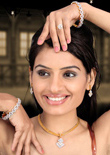Diamond - Cut « BACK
The fourth C of diamond is Cut. While nature determined the color and clarity of a natural diamond, man is responsible for the cut quality which brings it to life.The cut is perhaps the most fundamental attribute to consider when it comes to judging a diamond. How a diamond is cut and polished from its rough form is what determines its brilliance, fire and scintillation, or overall sparkle. For this reason, cut also plays a large part in determining the price of a stone and it is therefore important to be acquainted with all the factors that affect the quality of a cut before purchasing. Diamond cutting is the art and science of creating a gem-quality diamond out of mined rough. The cut of a diamond describes the manner in which a diamond has been shaped and polished from its beginning form as a rough stone to its final gem proportions. The cut of a diamond describes the quality of workmanship and the angles to which a diamond is cut. Often diamond cut is confused with "shape". Most diamonds are cut round with a full 58 facets, and a good cut, or make, has more scintillation, more sparkle. The shape of the diamond, however, is largely a matter of personal preference and does not directly affect the value. It is the work of a master cutter that allows the diamond to be cut in such a way as to permit the maximum amount of light to be reflected through the diamond, and that's a great reflection on you. It is the cut that enables a diamond to make the best use of light.
There are mathematical guidelines for the angles and length ratios at which the diamond is supposed to be cut in order to reflect the maximum amount of light. Round brilliant diamonds, the most common, are guided by these specific guidelines, though fancy cut stones are not able to be as accurately guided by mathematical specifics. The techniques for cutting diamonds have been developed over hundreds of years, with perhaps the greatest achievements made in 1919 by mathematician and gem enthusiast Marcel Tolkowsky. He developed the round brilliant cut by calculating the ideal shape to return and scatter light when a diamond is viewed from above. The modern round brilliant has 57 facets (polished faces), counting 33 on the crown (the top half), and 24 on the pavilion (the lower half). The girdle is the thin middle part. The function of the crown is to refract light into various colors and the pavilion's function to reflect light back through the top of the diamond.
Tolkowsky's calculations included some approximations. He calculated the ideal dimensions as:
- Table percentage (corner-to-corner diameter of the table divided by overall diameter) = 53%
- Depth percentage (overall depth divided by overall diameter) = 59.3% (not including adjustments for the culet height and girdle thickness)
- Pavilion Angle (angle between the girdle and the pavilion main facets) = 40.75%
- Crown Angle (angle between the girdle and the crown's kite facets) = 34.5%
- Pavilion Depth (depth of pavilion divided by overall diameter) = 43.1%
- Crown Depth (depth of crown divided by overall diameter) = 16.2%
The culet is the tiny point or facet at the bottom of the diamond. This should be a negligible diameter, otherwise light leaks out of the bottom. Tolkowsky's calculations included neither a culet nor a girdle. However, a girdle is required in reality in order to prevent the diamond from easily chipping in the setting. The thick part of the girdle is normally about 1.7% (of the overall diameter) thicker than the thin part of the girdle. The further the diamond's characteristics are from the Tolkowsky's ideal, the less light will be reflected. However, there is a small range in which the diamond can be considered "ideal". Tolkowsky's calculations can be repeated for a narrow range of pavilion angles. Such calculations show a slightly larger table percentage, and a trade-off between pavilion angle and crown angle.
Today, because of the relative importance of carat weight in society, many diamonds are often intentionally cut poorly to increase carat weight. There is a financial premium for a diamond that weighs the magical 1.0 carat (200 mg), so often the girdle is made thicker or the depth is increased. Neither of these tactics make the diamond appear any larger, and both greatly reduce the sparkle of the diamond. So a poorly cut 1.0 carat (200 mg) diamond may have the same diameter and appear as large as a 0.85 carats (170 mg) diamond. The depth percentage is the overall quickest indication of the quality of the cut of a round brilliant. "Ideal" round brilliant diamonds should not have a depth percentage greater than 62.5%. Another quick indication is the overall diameter. Typically a round brilliant 1.0 carat (200 mg) diamond should have a diameter of about 6.5 mm. Mathematically, the diameter in millimeters of a round brilliant should approximately equal 6.5 times the cube root of carat weight, or 11.1 times the cube root of gram weight, or 1.4 times the cube root of point weight.
When a ray of light touches the surface, part of it is reflected back. This is external refraction.
- The rest of the ray penetrates the stone and moves through it. This is known as refraction
- The part of the ray reflected back to the surface exits, broken into spectral colors in a prism-like effect. This is known as dispersion.
- All of these elements contribute to the appearance of a diamond.
Elements of diamond beauty can be described as brilliance (all light returning to the eye), dispersion or 'fire' (seen as white light is broken into spectral colors), contrast patterns (contrasting light and dark areas created by the viewer's reflection) and scintillation or 'sparkle' (seen as the diamond, the light source or the observer move). These qualities combine to create the life of the diamond and the way it reacts to lighting and environment
Out of the 4 C's, color and cut are the two most important characteristics of a diamond. Do not compromise on color. A "H" color or better is usually best. If the diamond is poorly cut, the color and clarity can not make up for it. The cut of a diamond is what makes a rough diamond sparkle and shine. If a diamond is poorly cut, the light that enters the diamond from above will leak out of the sides and bottom of the stone, and the diamond will not have the optium amount of sparkle or fire-regardless of its color or clarity. Please use the charts below as a guideline in assisting you in your search.




